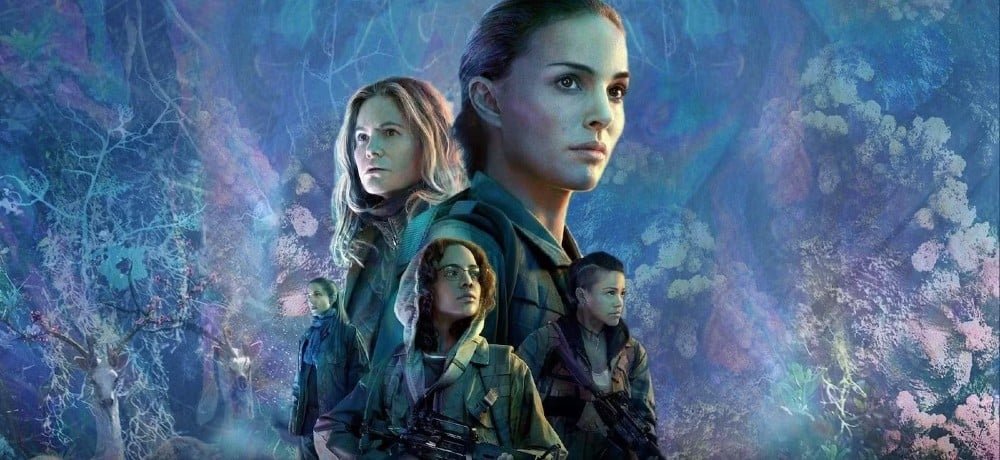


[Editor's Note: This article contains Annihilation spoilers]
The scariest part of Annihilation (2018) isn’t the bear that screams in a dead woman’s voice. It’s not the tumors, the mutations, the slow detachment from time or self. The scariest part is this: inside the Shimmer, nothing hates you. Nothing wants revenge. Nothing even notices you're there.
The Shimmer, a glowing zone of biological chaos spreading from the site of a meteor crash, rewrites everything inside it. DNA refracts. Flora grows with fingerprints. People don’t return, or worse, do.
The horror here isn’t destruction. It’s succession.
This isn’t a monster movie. No curse, no climate change sermon, no last-minute salvation. Annihilation trades moral arcs for ecological entropy. It offers ecohorror without retribution and posthumanism without ascension. The planet doesn’t revolt. It just forgets us. What replaces humanity isn’t evil. It’s just… other.
Posthumanism, in its simplest form, asks what happens when the category of “human” starts to fray. When biology, memory, and identity stop behaving. When selfhood loses copyright. In Annihilation, it isn’t a philosophy. It’s a shimmer in your bloodstream. A mimic learning your movements. A body gone uncanny while still technically alive.
Evolution here isn’t a ladder. It’s a remix. The body doesn’t grow stronger. It just stops checking in. A cell copies the wrong thing. A memory glitches. A name you’ve always had starts to taste foreign. You don’t die. You just… drift out of frame.
Posthumanism is no longer a theory. It’s a startup deck. A talking point at techno-futurist retreats. The future is being prototyped by people like Elon Musk, Sam Altman, and Peter Thiel, men who casually drop phrases like “AGI” and “radical life extension” while privately investing in blood boys and brain uploads. Their vision of humanity is sleek. Streamlined. Optional.
Not everyone is meant to come along. That part isn't in the press release.
They’re trying, with straight faces, to make natural selection unnatural, keeping it selective. Survival of the richest. Their solution to human fragility isn’t care or repair. It’s escape. A future where mortality is a glitch for those who can’t afford the patch.
They don’t want to fix the species. They want a refund.
When they talk about the future, they don’t mean our future. They mean a quieter, cleaner one. With fewer errors. Fewer failures. Fewer people. A version of tomorrow you can only access if you’ve got the bandwidth and the bank account to upgrade.
And for the rest of us? A slower extinction, sold back as inevitability.
Annihilation is not interested in that vision. Its posthumanism is not metallic. It’s wet. Swampy. Pulsing. It's biology gone baroque. In the Shimmer, plants bloom in the shape of people. Voices root themselves in beasts. Memory becomes architecture. The body doesn’t die so much as unravel into something that photosynthesizes.
Lena enters to find out what happened to her husband, Kane, who came back from the Shimmer moving like a badly dubbed version of himself. Not haunted. Just… unfinished. A man-shaped draft.
What she finds inside is not revelation, but decomposition. Not of life, but of taxonomy. Time folds. Pain loops. Trauma becomes landscape. One woman becomes a bouquet. Another becomes a sound. A scream survives without its source, trapped inside a creature that should not be able to mourn.
There are no metaphors here. No allegories. Just flesh behaving badly.
And then comes the mimic. The not-quite-person that moves like Lena. Breathes when she does. Learns her rhythm. Not to kill her. Not to replace her. Just to understand form. It doesn’t want. It doesn’t need. It simply becomes.
And it’s patient.
When Lena leaves the Shimmer, if that’s still her, the shimmer doesn’t stop. It’s in her now. In Kane. In the way they look at each other like strangers sharing a memory. Nothing is visibly wrong. Everything is just slightly off. Like a dream you’re still halfway inside.
And no one is coming to ask questions.
This is what Annihilation understands: the deepest horror isn’t the end of the world. It’s a world that keeps going without needing you in it. No fire. No bang. Just indifference. Just process.
This is ecohorror that doesn’t care how you feel. There’s no wrath. No judgment. No interest in revenge. Just a system realigning itself, rewriting life from the bottom up. Your body isn’t sacred. Your mind isn’t exempt. Your grief isn’t special.
Posthumanism here isn’t about becoming better. It’s about becoming irrelevant. Still alive, still functional, just no longer human in ways you recognize. And what comes next won’t be angry. It won’t be kind. It won’t be anything you can talk to.
The world didn’t end.
It just stopped checking in.
And we, so sure of our place, missed the handover.
---